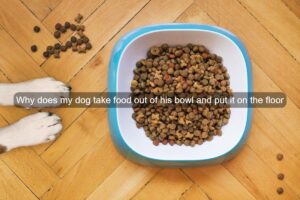House training or indoor dog potty training is one of the most important things to teach when you bring a puppy or a neglected dog home. Potty training an adult dog is not very different from training a puppy. Puppies learn fast but are more difficult to train as they are in the learning stage and are stubborn most of the time. While adult dogs learn slower than puppies, it is easier to train them.
They might have developed bad habits due to past accidents or neglect, but they are as eager to please you by learning as you are to train them. They just need a consistent schedule and some praise to keep going on track. Here comes the question, how to potty train a puppy or older dog? We have come up with simple steps that you can follow for outdoor or indoor dog potty training. Let’s take a deep dig into the Dos and Don’ts of housetraining!
Dos of Housetraining a Puppy or Older Dog
1. Establish A Routine
The most important step for house training your dog is to set up a routine. For both puppies and adult dogs, it takes time to build a schedule. Once they pick up on a routine, things will go a lot easier. Try to take them out;
- When you wake up.
- After meals.
- When your puppy wakes up from naps.
- After playtime.
- Before traveling.
- Before bed.
Try not to hang out and take them for potty right on the established schedule. Try to use the same path to the dog potty area you once used. This familiarity will help him understand that it is time to do the job. The maximum potty break should be 3-6 hours for puppies and 6-8 hours for adult dogs.
2. Set Up a Cue
Sometimes, puppies and even adult dogs need to go ASAP. Setting up a cue can greatly help in this regard. They just need to bark, sit by the door, urge you to go to the dog potty area or ring a bell. Try to teach them an obvious cue to prevent accidents.
Also, if you want your dog to do the business due to his lack of interest, use specific words as commands like “go potty” or “poo”. It reminds him of the business that is scheduled to finish.
3. Mark a Bathroom Spot
Select a location that is not too far from your house. In case you want indoor dog potty training, choose a confined spot inside the house. Take him directly to the marked spot and use specific commands. The spot should be distraction-free.
4. Use the Crate or Confinement Space
A crate or a confined space gives your dog a private and secluded area. Due to their natural instinct, they tend to keep their space clean. In this way, they will avoid accidents when you are unable to watch them. Once you let him out of confinement, take your buddy directly to the bathroom spot.
5. Positive Reinforcement
Always use positive reinforcement for outdoor or indoor dog potty training. It works best for training both puppies and older dogs. Praise and reward him whenever he gets his job done properly.
6. Learn About His Habits
Track the daily habits of your buddy as a part of the dog care routine. Make a chart or keep a notepad to track the time and place where your dog is comfortable doing his business. In this way, you will get a better idea about the times to go to the dog potty area or about the length of the potty break. Learn about the ways he adopts to tell you about nature calls. Watch for the following signs
- Frequent Sniffing
- Seeking out a hiding spot
- Pacing or circling
- Sitting by the door and going there frequently
- Pawing at you or at the door
- Returning to a spot of past accidents
- Whining or barking aggressively
- Licking their genitalia
7. Walk On Leash
Always walk your dog to his bathroom spot on a leash. This keeps you close to him to reward his good behavior and you can supervise him in a better way.
8. Supervise
Always be wary of the accidents that might occur due to your negligence. Supervise his behaviors and watch for the signs of circling, whining, sniffing, or pacing. Restrict their access to other areas of the house in absence of your supervision.
9. Reward
Reward your dog for his good behavior once he has done the job successfully. After this, play with him for a few minutes. It helps create a positive connection between eliminating and leaving the dog potty area.
10. Repeat
Patience is the key! Some dogs learn in less than a week and some take, as we would call it, eternity! Whether you train a puppy or a grown dog, training should be consistent. Repeat the above-mentioned step every time nature calls your buddy. In this way, your dog will learn faster than you would have expected.
Don’ts of Housetraining a Puppy or Older Dog
1. Potty Pads with Crates
Forcing your puppy or older dog to eliminate potty pads inside the house is a big “No” during housetraining. It confuses them about the indoor dog potty areas they are allowed or not allowed to soil.
2. Reprimand or Punish
Verbally or physically abusing a pet is strictly prohibited. Reprimanding or punishing your dog for accidents or failing to follow your commands also establishes a negative connection with the trait. It makes the training process more difficult. Therefore, avoid punishing your dog for accidents.
3. Inconsistency
Failing to stick to a schedule confuses the dogs, especially young puppies. It can lead to potty accidents in the house. So try to create and maintain a strict routine. It is your job to be consistent in watching over your dog.
4. Leaving the Accidents on Spot
The smell or stains from previous accidents is like a bathroom signal for your dog. Therefore, clean the accidents thoroughly before your pup uses it as an indoor dog potty area again.
5. Neglect
Never neglect your puppies’ or dogs’ needs. They do not have a steel bladder and cannot hold for more than a certain limit. It is cruel if you confine them to space and forget to take them out for their business.
FAQs
What is the best time to start house training your dog?
The best time to housetrain your dog is the weekend (If you need to leave your home for work). In this way, you can allow your dog for frequent potty breaks without leaving him for longer periods and thus the training would be effective.
Is potty training an adult dog more difficult?
No! House Training an older dog is much easier than training a puppy. They just need a firm routine, strict feeding schedule, and positive reinforcement-based training.
How long does it take to housetrain a dog?
For a very young puppy, it takes four to six months to potty train him. While older puppies or adult dogs, with consistent training, can be house trained in two weeks to four months.
When should you start potty training your puppy?
Start potty training your puppy when he is between 12 to 16 weeks old. It is because younger puppies do not have enough bladder control to be trained.





